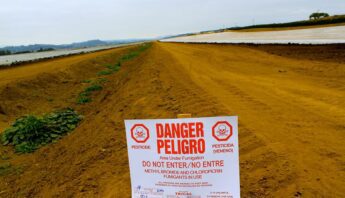A recent report from UCLA researchers evaluated the role of California county agricultural commissioners (CACs) and their permitting practices for restricted use pesticides. CACs are supposed to evaluate safer alternatives and cumulative exposures of these pesticides, and their power lies in their ability to grant permits to applicators.
A recent report from UCLA researchers evaluated the role of California county agricultural commissioners (CACs) and their permitting practices for restricted use pesticides. CACs are supposed to evaluate safer alternatives and cumulative exposures of these pesticides, and their power lies in their ability to grant permits to applicators.
Restricted pesticides have additional requirements for use. For example, the notorious surface and groundwater contaminant atrazine has restrictions around applications in close proximity to waterways. CACs are responsible for knowing the local conditions and using that information to help determine whether a restricted use permit should be approved. But as it turns out, that’s not really happening.
What do CACs do?
In California, pesticides that are sold or used in-state must be registered by the California Department of Pesticide Regulation (DPR). At the county level, CACs review permit applications for use of restricted pesticides.
There are 56 CACs in California. Each one is appointed by their county’s Board of Supervisors and they have several roles, such as incident investigations when there’s a pesticide poisoning or drift incident, pesticide use enforcement, and managing pest detection and pest eradication programs.
CACs have the power to deny applications “where feasible safer alternatives or mitigations measures are available.” Mitigations can include strategies to reduce or limit pesticide exposures, like buffer zones.
CACs are potentially the main local protection in California counties against cumulative exposures, defined in this report as exposures “associated with simultaneous or sequential application of two or more materials at the same field or at adjacent fields.”
So that’s what CACs are supposed to be doing.
This report found, however, that almost nothing has been done by CACs regarding two areas that could provide some protections against pesticide exposures: consideration of alternatives to restricted pesticides, and addressing cumulative impacts.
Questions worth asking
The report addressed two main questions:
(1) To what extent do CACs effectively evaluate restricted material permit applications with respect to (a) availability of alternatives to the requested pesticides and (b) potential adverse cumulative exposures?
(2) What policy and institutional changes, if any, are necessary to improve DPR’s and the CACs’ practices regarding the evaluation of alternatives and of cumulative exposure?
For the assessment on alternatives, the researchers chose chlorpyrifos as a focus. Chlorpyrifos is the known neurotoxic pesticide that EPA scientists suggested be banned from agriculture based on its effects on very young children’s developing brains. We’re currently waiting to find out what action EPA will take after being ordered to make a decision by the 9th circuit court.
Cumulative exposure was evaluated by examining decisions made on three major fumigant pesticides used in California — metam sodium, chloropicrin and 1,3-dichloropropene (also known as Telone). These fumigants are often applied together and are also extremely prone to drift, which means California communities where these are used get exposed frequently during the time of year that fumigants get applied. The fumigant pesticides are subject to the schools buffer zone rule that went into effect in California on October 1st, 2017.
Who watches the watchers?
The report found that for more than 40% of the CACs reviewed, there was no evidence whether they took alternatives into account when permitting uses for chlorpyrifos. Just under 30% of CACs expressed a commitment to using alternatives, and another 30% showed a limited commitment to alternatives.
The CACs who responded to the researchers’ public records requests did not report having any specific written guidance on alternatives evaluation. According to the report, the CACs pass this responsibility of evaluating alternatives to the applicant’s pest control advisor. There also seemed to be no oversight by CACs of the work that the pest control advisors might be doing to evaluate alternatives. So. It looks like basically nothing is happening locally in terms of evaluation of chlorpyrifos alternatives.
For the cumulative exposure evaluation, the researchers found that CACs receive no guidance at all from DPR, and that the CACs do not consider cumulative exposure when permitting restricted pesticides.
How do we fix this?
I didn’t mention that (meaningful) consideration of alternatives and addressing cumulative effects by pesticide programs are both mandated by state law. This report indicates that neither is happening, and that there’s no accountability for not following these laws.
One major issue for alternatives evaluation by CACs is a lack of guidance from DPR, and the report’s authors made a number of recommendations to remedy that. DPR needs to develop guidance on safer alternatives for CACs or pest control advisors, and support the capacity of the CACs for identifying and evaluating alternatives.
For cumulative exposures, there are a number of recommendations, but probably the most important one is that the state actually identifies cumulative exposure scenarios when registering and permitting pesticide uses.
DPR has a long to-do list from this report. The authors outline actions the agency can and should take to ensure laws are enforced and public health is protected. We hope they get to work.








